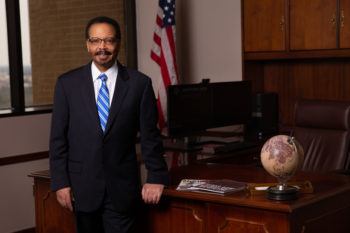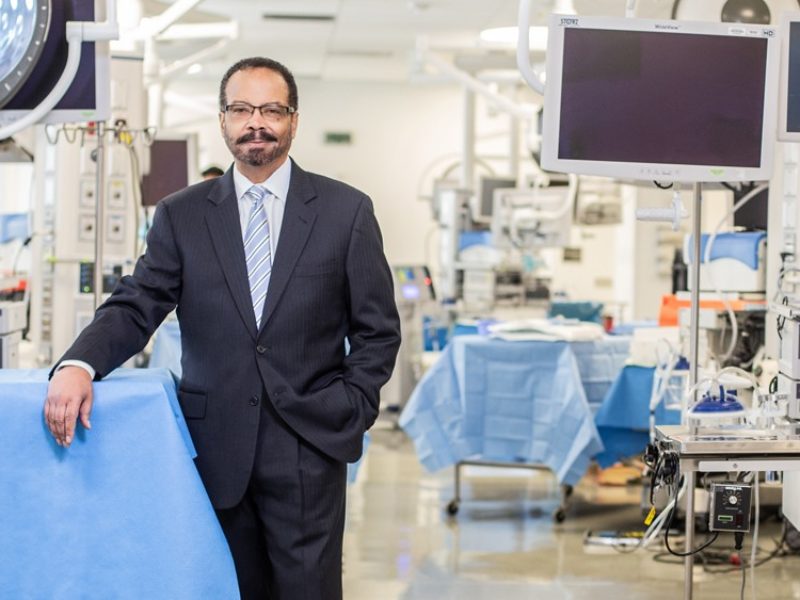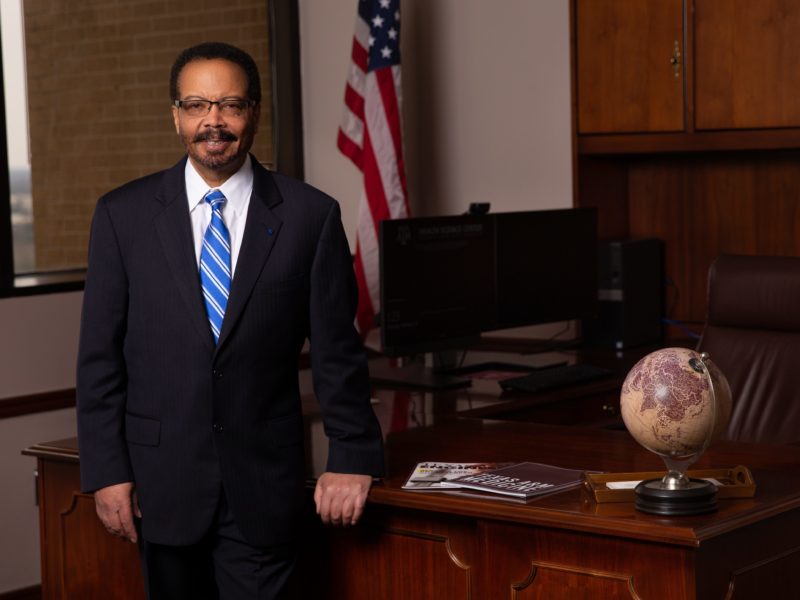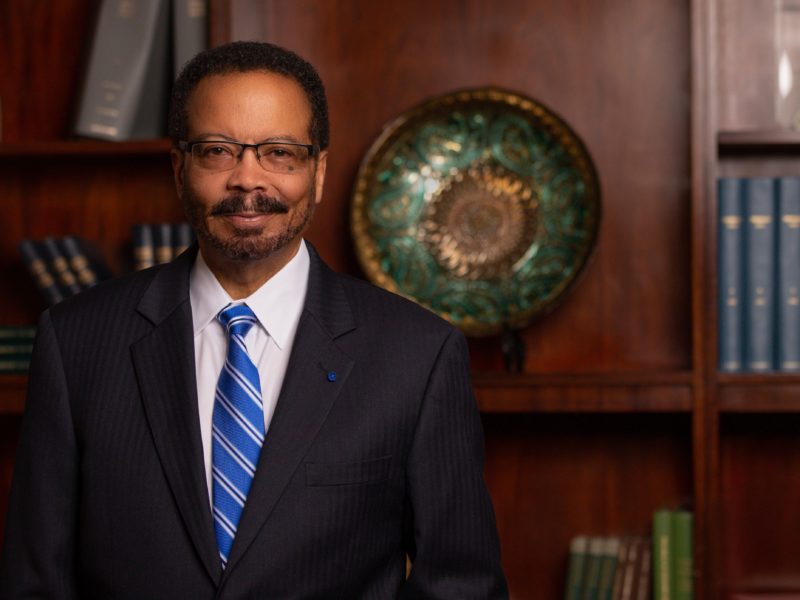Texas A&M Medical Researcher Confronts Societal Ills That Science Can’t Solve

Dr. Roderic Pettigrew has a goal both simple and profound: improve the well-being of every human on the planet.
As chief executive officer of Engineering Health and executive dean for the Engineering Medicine program at Texas A&M University, he is leading a unique effort in partnership with Houston Methodist Hospital that weaves together different scientific disciplines to address some of the biggest human health challenges.
“This is not just Houston, it’s not just Texas, it’s not just the U.S.,” Pettigrew said. “This is for the planet. It’s universal.”
Pettigrew’s vision is that we all “Die Healthy,” by which he means he wants to make it possible for everyone to live out their lives without pain or suffering. We all grow older, and we all will die, but Pettigrew is committed to ending the illness that leads to pain and suffering as part of that process.
For Pettigrew, it’s an ideal that transcends medicine, that springs forth from a childhood in a tight-knit nuclear family that taught him to treat everyone with respect and dignity, even amid a society of oppression and discrimination.
The anguish he felt in growing up in the segregated South came rushing back to him as he watched news reports of the shootings of Ahmaud Arbery and Rayshard Brooks in Georgia in February and June and the death of George Floyd under the knee of Minneapolis policeman Derek Chauvin in May. He was particularly struck by the casualness with which Chauvin, hands in his pockets, kneeled on Floyd’s neck for almost nine minutes.
“I couldn’t sleep,” Pettigrew said. “I felt compelled, as John Lewis exhorted us, to say something, to do something.”
He wrote a personal essay about his own experiences growing up in the Jim Crow South that is available on the Texas A&M website and was published by the Association of American Medical Colleges (AAMC) as an Insights contribution.
In the essay, he recounts growing up in Albany, Georgia, in the 1960s and how, when he was about 12 years old and desperately needed braces, the only orthodontist in town refused to treat him. The orthodontist told Pettigrew’s father that while “he didn’t have anything against black people, if I take your son as a patient – for dental treatment, it will kill my business.” His father persisted for months, imploring the orthodontist to reconsider and even getting another orthodontist in Atlanta to ask the one in Albany to change his mind. Eventually, the orthodontist relented, but there were conditions: Pettigrew had to come after hours and enter through the back alley. He did that for two years until his teeth straightened.
“I was well aware that this was not the norm,” Pettigrew recalled. “I knew it wasn’t right. I knew it was disparate treatment, based purely on skin tone.”
But he also knew that hatred, bigotry and discrimination were ingrained in the society he was living in. And he recognized the pettiness and absurdity of it. He remembers as a young child looking at water fountains labeled “White” and “Colored” and studying the path of the pipes underneath, following them until they came together. “I thought, ‘it’s the same water,’” he said.
In school, he found a refuge: science. “The thing about science was its natural appeal and it was bigger than these petty, racially based behaviors,” he said. “It was bigger than that. It was bigger than Albany, Ga. It was universal, and it allowed me to have my mind operate at that level — the questions of the universe.”
Science captivated him. He started to learn how life really works, which made him realize the shallowness of the racism that surrounded him. The human condition, he realized, was much greater.
He was fascinated by the Apollo missions to the moon — President John F. Kennedy’s call to put a man on the moon at the beginning of the decade was inspiring because it “was intriguing and rose above racism.” Even more, he found the problem-solving nature of science enticing. He realized that when things go wrong, it’s an opportunity to learn how to fix them.
In high school, he was drawn to physics, and then at Morehouse College in Atlanta, as a Merrill Scholar, he became fascinated with using physics to solve human problems. He took to heart a quote from Morehouse President Benjamin Mays, considered an intellectual icon of education and the American civil rights movement: “Whatever you do, strive to do it so well that no man living and no man dead and no man yet to be born could do it any better.”
Pettigrew went on to get a master’s in nuclear science and engineering from Rensselaer Polytechnic Institute and a doctorate in radiation physics from the Massachusetts Institute of Technology. Then, he applied for medical school in the one-of-a-kind accelerated program at the University of Miami and got rejected.
He’d never been turned down by any school he’d applied to, including the physics programs at Stanford, and Cornell as well as MIT. He was stunned, but also curious. So he did what any scientist would do — he asked why. He called the head of the admissions committee to find out what happened. Was this something he could fix? What did he need to know before he reapplied? After several phone calls and a conversation with a senior committee member, he suddenly received an acceptance letter. Again, he was curious, and he again he called the admissions coordinator. All he was told was the rejection was an error.
Only later, after he matriculated to the medical school and started taking classes did he find out what happened. A member of the admissions committee pulled him aside and told him that another committee member, a white South African, had opposed his application, saying he wasn’t consistent with the kind of elite individual the school should accept. The committee had ranked the applicants, and Pettigrew was well in the range of those identified for acceptance, but the South African convinced other committee members to vote against him. When he had called to get a factual or data-based explanation, the committee chair realized there was none to give. Unable to defend its action, the committee decided to do the right thing.
Three graduate degrees and a lifetime devoted to the intellectual pursuit of science, and suddenly he felt like he was once again standing in a back alley in Albany. He’d experienced racism in academia — a professor who wouldn’t shake his hand because he was black, for example — but it had been something to overcome, something to move past as he moved forward. This time, it had almost blocked his career, his dreams.
“It’s a horrible feeling,” Pettigrew said. “It hurts and baffles you. Part of it is just being put out with man’s inhumanity to man, and it’s combined with having experienced stuff like that all your life. No matter how good you are, no matter how great your visions is, no matter how pure your motives are, you still run up against this.”
He knows he isn’t alone. Since his essay was published, he’s heard from other black professionals, recounting similar experiences. Dr. Kafui Dzirasa, a neurobiologist and junior faculty who teaches psychiatry and behavioral science at Duke University, wrote in the journal Cell about his own experiences with racism.
“We’re from different generations, and the fact that he wrote about similar experiences shows how systemic the problems are,” Pettigrew said.
After finishing medical school and training, and a year as a clinical research scientist in the MRI industry, he joined the faculty of Emory University, where he practiced and researched radiology focused on non-invasive cardiovascular imaging, also becoming a professor of cardiology and a professor of bioengineering at the Georgia Institute of Technology. He went on to become the founding director for the National Institute of Biomedical Imaging and Bioengineering at the National Institutes of Health, and is recognized for pioneering four-dimensional imaging of the cardiovascular system using magnetic resonance imaging.
In 2017, he joined Texas A&M to lead EnMed and EnHealth, the first program in the country that seeks to comprehensively integrate engineering into health-related disciplines. In EnMed, students earn both an MD and master of engineering in just four years. Graduates are also required to invent a solution to a healthcare problem.
“Medicine is not just biology,” Pettigrew said. “It’s not just chemistry. It’s not just physics and genetics. It’s all of that, and it’s also engineering. All of that is combined and integrated, interwoven and fused together to create this thing called life. The goal is to understand all those inter-relationships and develop the next generation of scientists who can innovate solutions to some of humanity’s most profound medical problems.
“The dream that I have is to get us all to have health and maintain health through the entirety of our lives,” he said.
Fixing society’s ills, however, requires something beyond medicine or science. In this moment when more people are speaking up and demanding changes to eradicate systemic racism, Pettigrew is hopeful that we can find the solution in the humanity that binds us all.
“It is within us now,” he said. “We must realize that.”
It was announced Monday that Pettigrew will receive the National Science Board’s highest honor — the Vannevar Bush Award, a lifetime achievement award named after the man who was a science advisor to President Franklin Roosevelt during World War II, helped establish federal funding for science and engineering as a national priority during peacetime and was behind the creation of the National Science Foundation.





